1 August, 2000
August 1 , 2000
Matanuska Glacier, Alaska
Today I spent another long day on the ice, this time watching and
helping Bob Bigl (sounds like beagle) drill holes through the ice to the
bottom. Bob is an engineering technician with the Cold Regions Research
and Engineering Lab and is quite fun to be around and talk to. He works
out of the CRREL office in New Hampshire and was accompanied by Brian
Harrington who’s an engineer at the same office. Drilling through the
ice is obviously something that requires sophisticated equipment. It
also takes quite an effort to get this equipment packed onto sleds and
hauled over the rough terrain of the terminus area to the drill site.
Bob seems to have designed quite an effective rig and has the
transportation logistics down to a science. I am amazed at how
efficiently his operation works.
His rig does not drill into the ice as we would think of it. Rather, it
uses hot water to melt its way down and it does so very well. In
preparation for “drilling” a small area is sprayed clean of all rocks
and sediment. A hole is then chiseled into this clean ice that will
serve as a reservoir for water that returns to the surface as new hot
water is injected into the bore hole. Due to the flow rate of new water
into the bore hole, the water that comes up is relatively warm and is
pumped out of this reservoir hole in the ice back to a tub where it is
filtered of any sediment before going through the boiler again. It is
much more efficient to do this than to heat local surface meltwater
which is always at the freezing point.
After the reservoir has been prepared the drilling is ready to begin.
The drill tip is actually like a long brass plumb bob with a hole
through the center. A coil of a special type of hose is attached to this
and the hot water is pumped from the boiler through the hose to the
drill tip. The water temperature is about 200 degrees Fahrenheit and
comes out the point of the drill at around 400-450 pounds per square
inch in a narrow stream. With that kind of pressure and temperature the
ice is simply melted away in advance of the tip as it is lowered. It can
easily drill over one meter per minute by this method.
During the drilling process a computer monitors everything that’s going
on. The depth and loadcell are displayed on a real time graph. The
loadcell reflects what sort of weight the drill rig is supporting. When
the drill just hangs there it is simply recording the weight of the
“drill bit” and whatever hose hangs below. When water is fired out the
tip this load will decrease a bit. If they start to go through a debris
band (small parcticles of rock, sand and sediment) the load gets even
lower as the water has a harder time melting ice through these layers.
The computer has digital displays for the water temperature entering the
hose, the pressure of the water, the flow rate of water and the drilling
rate.
Eventually the drill reaches the basal ice layer at the bottom. This
layer is loaded with debris and the loadcell reflects this very well. At
some point, whether at the bottom or even before, the ice will drain
down into the bore hole to a certain depth. Back on July 7 I mentioned
the possibility of a water table in the glacier down at some depth. It
turns out that all glaciers have a water table. It can be found in any
glacier by going down roughly 10 percent of the ice thickness. Due to
the density differences of ice and water, 10 percent of ice will float
above the water. This happens with ice cubes, icebergs and glacier are
no different. The buoyant effect of the underlying water is partially
the cause of the more rapid advance of glaciers during the melting
season. Once the drill reaches the bottom water or a conduit connected
to the bottom, the bore hole will drain down to the equilibrium point.
The holes that have been drilled so far have been done on the same line
that Greg Baker used for his seismic tests. The holes have shown that
Greg’s techniques for locating the bottom of glaciers works perfectly as
the results of drilling has confirmed his earlier measurements. Several
researchers are interested in what’s going on at the bottom of the
glacier here. Once the holes are drilled a variety of sensors can be
lowered into it for collecting data. In addition, Isaac Larsen is going
to inject dye samples into some holes in a study similar to ours.
It’s odd how you discover new things sometimes. By the time everything
was finished at the first hole it was already about 1:00. I had been
battling the cold all day in spite of nice sunny weather. It occurred to
me that there is ALWAYS a cold stiff wind barreling down the glacier
valley. You only notice this if you’re out on the flat open sections of
white ice. In other locations you can become shielded from the wind by
mounds or ridges of rock and ice. If you’re fairly active you don’t
notice the cold. But just stand around a lot and it really starts to
penetrate into your core. Drilling over 100 meters required a LOT of
standing around! Like so many other things here I just had to think
about this briefly before realizing that it’s a density driven wind. Up
higher on the glacier the ice is cooling the air which makes it more
dense. This cold, dense air is simply sinking and flowing down the
valley much like the glacier itself is. Once we left the ice and got
back on dry land it was t-shirt weather and there was no noticeable wind
at all.
Marvin Giesting
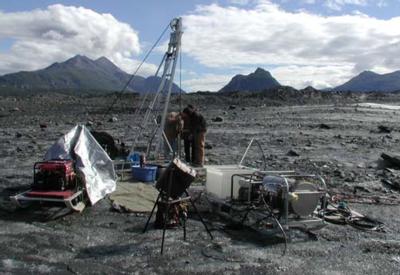
The whole drilling operation is moved about on four sleds. On the right is the boiler and filtering tank sled. On the left is the AC power generator and computer (under a tarp to aid in viewing the laptop screen). The drill rig sled is the background. One other sled not shown holds numerous containers of gasoline and diesel fuel. All this is moved around by fourwheelers equipped with special tire chains.
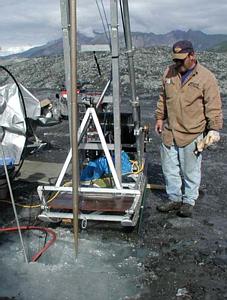
Bob Bigl looks on as the drilling begins with a jet of hot water shooting from the tip. A pump in the hole to the left returns water to the filtration tank. It is then sent to the boiler to be reheated. One of the fourwheelers is in the background.
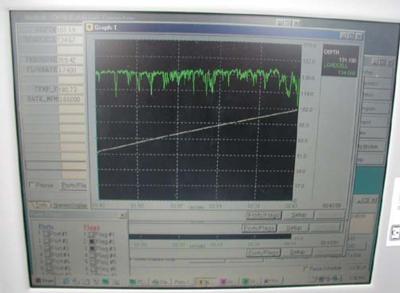
A real time graph shows depth (white line) and the loadcell (green). The load cell drops significantly whenever a debris band is encountered. This is confirmed with an upwelling of sediment laden water in the bore hole.
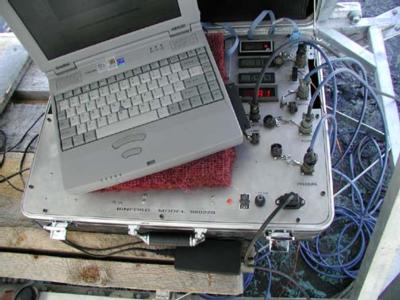
The computer records data as it is collected by the BINFORD Model 980228 (Bob Bigl humor).
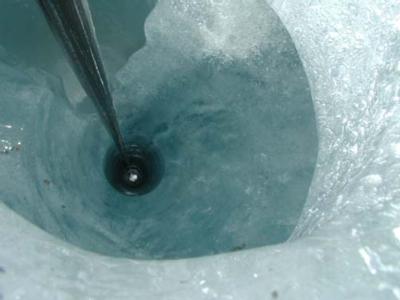
Looking down the hole. The diameter is larger at the top and gets smaller at the bottom due to more chance of melting in the return water nearer the top. The white spot at the bottom is just a reflection of the camera flash. The depth to the water was about 26 feet or so. This hole will eventually close off to the bottom in a few days due to the deformation and flow of the ice at deeper levels.
Contact the TEA in the field at
.
If you cannot connect through your browser, copy the
TEA's e-mail address in the "To:" line of
your favorite e-mail package.
|
